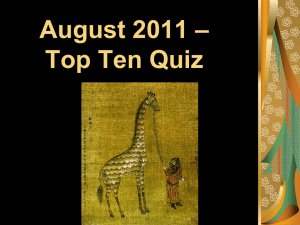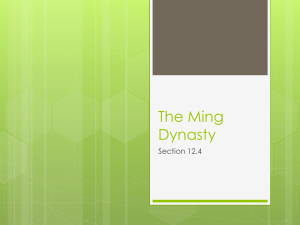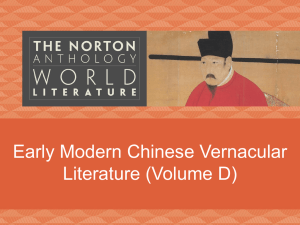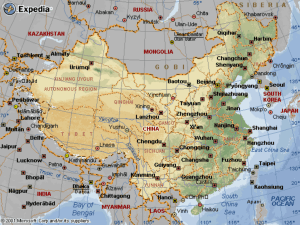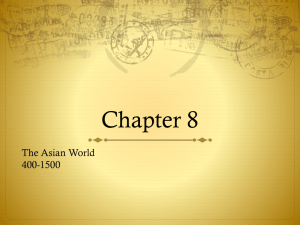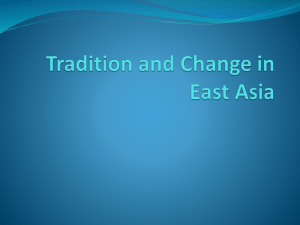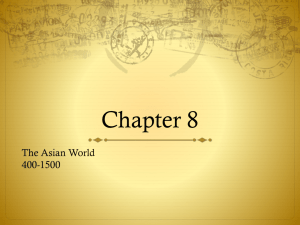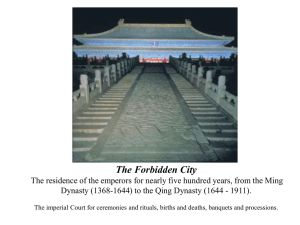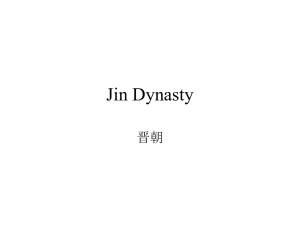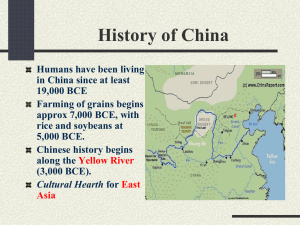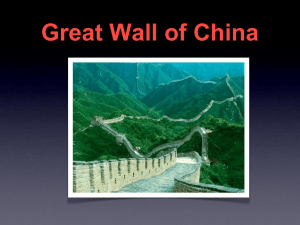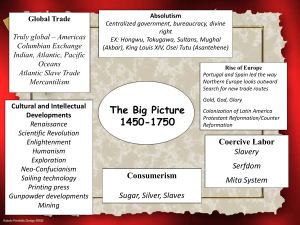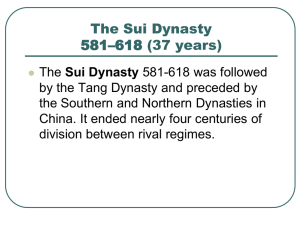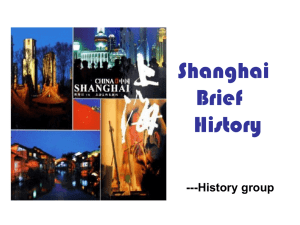LATER DYNASTIES OF CHINA
advertisement
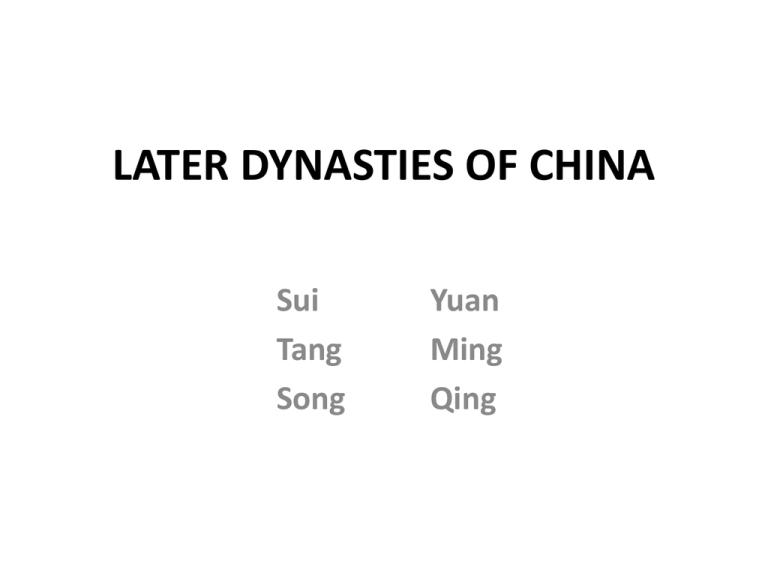
LATER DYNASTIES OF CHINA Sui Tang Song Yuan Ming Qing • After the fall of the Han Dynasty, military leaders split China into rival kingdoms, which led to a period of warfare called the Period of Disunion – Lasted for more than 350 years and ended when a northern ruler named Wendi reunified China and founded the Sui dynasty Sui Dynasty 581 to 618 • Wendi was the first emperor of the dynasty and was also known as Yang Jian – He reunified China – He also established a centralized gov’t and restored order • His son, Emperor Sui Yangdi, built the Grand Canal that linked northern and southern China – It was a 1,000 mile waterway that made it easier to trade and ship rice – Millions of peasants were forced to work on the Grand Canal and hundreds of thousands died • High taxes and military failures led to Yangdi’s assassination and the end of the dynasty Tang Dynasty 618 to 907 • A Sui general seized power and founded the Tang dynasty, which was a period of prosperity and cultural achievement – Tang rulers began by instituting reforms, such as giving land to peasants, and restoring the civil service exam – China also expanded, regaining lands in Central Asia, along with gaining influence over Korea – Many early Tang rulers were Buddhists, although Buddhism lost official favor later on – Trade revived and the Silk Road once again prospered – Wu Zhao – first and only female emperor • Inventions – Invented gunpowder – used mostly for fireworks • Fire-lance: weapon that shot out flame and projectiles up to 40 yards – Perfected the magnetic compass • Sailors could more accurately determine direction and navigate – Developed woodblock printing • Books could be mass produced • Gov’t corruption, high taxes, nomadic invasions, and peasant rebellions all led to the decline of the Tang dynasty – A powerful general killed the emperor, ending the dynasty Song Dynasty 960 to 1279 • After the Tang, China once again split apart until it was reunified under the Song Dynasty – Under the Song, Chinese civilization became the most advanced in the world • Enlarged the gov’t bureaucracy and reformed the civil service exam – Exams tested students’ knowledge of Confucianism – Those who passed the exam became scholar-officials, the elite educated members of the gov’t • The exams were a pathway to gain wealth and status – Scholar-gentry = landed aristocrats who produced most of the candidates for the civil service exam – political and economic elite of China • Invasions by northern tribes forced the Song to move the imperial court farther south, but eventually they were conquered by the Mongols, leading to foreign rule in China The Mongols • The Mongols were nomadic people who were fierce warriors and skilled horsemen – Were divided into separate clans, each ruled by a khan, or chief – One khan, Temujin, conquered his rivals and united the Mongol clans • He took the title Genghis Khan, which means “universal ruler” • Genghis Khan organized the Mongols into a powerful military machine and his armies were highly mobile and could strike quickly – Used brutality and psychological warfare – Many people surrendered without a fight • With his armies, Genghis Khan created the largest land empire in history, controlling much of the Eurasian landmass – On his death, his empire was divided into four parts and given to his heirs – His grandson, Kublai Khan, completed the conquest of China Yuan Dynasty 1279 to 1368 • Kublai Khan defeated the last Song ruler and had himself declared emperor – This was the first time foreigners ruled China – He established his capital at future Beijing • Explorer Marco Polo was greatly impressed by this city • Kublai Khan kept the Chinese gov’t system in place, but its highest positions were staffed by Mongols – He distrusted the Chinese and limited their power – Mongols were made to live apart from the Chinese • Kublai Khan tried to expand his empire – Sent several invading forces into Southeast Asia, which all failed – He also tried to invade Japan twice, but failed again • These military losses, along with Chinese resentment of foreign rule, led to rebellion that ended the Yuan dynasty Ming Dynasty 1368 to 1644 • A peasant and his rebel army overthrew Mongol ruled and established a new dynasty, taking the title Emperor Hongwu – Hongwu reduced taxes and passed reforms to improve agriculture and trade – He also greatly expanded his powers as emperor, taking over more control of the gov’t • Ming emperors were more powerful than previous emperors • Ming rulers gained control of Korea, Mongolia, and parts of Asia • The Ming capital was established at Beijing – In the center the vast Imperial City was built, also known as the Forbidden City • One Ming ruler sponsored overseas voyages – Chinese admiral Zheng He led seven voyages that explored Southeast Asia, India, the Arabian Peninsula, and the east coast of Africa – Zheng He travelled with 300 ships • Made contact with the first Europeans since Marco Polo, the Portuguese – Restricted foreign trade to a few ports – Ming disliked the influence of Europeans, especially the missionaries – wanted to preserve China’s traditions – The Ming emperors decided to isolate China from the outside world • The main artistic achievement was the porcelain Ming vases • Decline due to weak rulers, corruption, and high taxes, which all leads to a peasant revolt – The Manchus, a group of people who live in Manchuria, invade and conquer the peasant revolt – The last Ming emperor commits suicide and the Manchus establish a dynasty Qing Dynasty 1644 to 1911 • The Manchus established the Qing dynasty, which would be the last dynasty of China • The Manchus adopted the Chinese political system and shared power with them – Showed respect for Chinese customs and maintained Confucian traditions – Remained separate from the Chinese and placed restrictions on them • In order to better identify rebels, the Qing gov’t ordered all men to adopt Manchu dress and hairstyles – Men had to adopt the queue = hair style in which the front is shaved with a braid or ponytail in the back • Missionaries were allowed to enter China – Qing emperors entertained Jesuit priests to learn about European intellectual advances • Foreign relations – Conquered Taiwan and Tibet – The Dutch began a thriving trade in Chinese goods • Had to accept China’s terms • The Qing dynasty would eventually fall to rebellion in 1911, mostly due to increasing Western influence and the efforts of European imperialism in the 1800s

